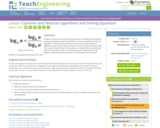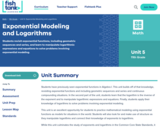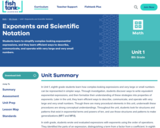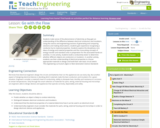
This tutorial presents a review of the definitions for pH and buffer solutions
- Subject:
- Science
- Material Type:
- Lesson
- Provider:
- Chemistry Collective
- Date Added:
- 08/03/2022

This tutorial presents a review of the definitions for pH and buffer solutions

Students continue an examination of logarithms in the Research and Revise stage by studying two types of logarithms—common logarithms and natural logarithm. In this study, they take notes about the two special types of logarithms, why they are useful, and how to convert to these forms by using the change of base formula. Then students see how these types of logarithms can be applied to solve exponential equations. They compute a set of practice problems and apply the skills learned in class.

Students use the Cabri Geometry II Plus software to solve a geometry problem. They move the vertex point that is common to two right triangles along the base to find the smallest possible sum of the length of the hypotenuse.

An introduction to pH and the pH scale. See examples of calculating pH of pure water, bleach, and orange juice. [11:38]
Khan Academy learning modules include a Community space where users can ask questions and seek help from community members. Educators should consult with their Technology administrators to determine the use of Khan Academy learning modules in their classroom. Please review materials from external sites before sharing with students.

How can an understanding of pH—a logarithmic scale used to identify the acidity or basicity of a water-based solution—be used to design and create a color-changing paint? This activity provides students the opportunity to extract dyes from natural products and test dyes for acids or bases as teams develop a prototype “paint” that is eventually applied to help with a wall redesign at a local children’s hospital. Students learn about how dyes are extracted from organic material and use the engineering design process to test dyes using a variety of indicators to achieve the right color for their prototype. Students iterate on their dyes and use ratios and proportions to calculate the amount of dye needed to successfully complete their painting project.

Geometric solids are explored in this video lesson. The tutorial defines and provides examples of six popular solids. Students can check their understanding with an assessment. [9:03]

To reinforce students' understanding of the human digestion process, the functions of several stomach and small intestine fluids are analyzed, and the concept of simulation is introduced through a short, introductory demonstration of how these fluids work. Students learn what simulation means and how it relates to the engineering process, particularly in biomedical engineering. The teacher demo requires vinegar, baking soda, water and aspirin.

Students revisit exponential functions, including geometric sequences and series, and learn to manipulate logarithmic expressions and equations to solve problems involving exponential modeling.

Students learn to simplify complex-looking exponential expressions, and they learn efficient ways to describe, communicate, and operate with very large and very small numbers.

Students can learn how to determine the formula for the volume of a rectangular prism with this video lesson. They can also check their understanding with an assessment. [5:14]

Students explore measurements of geometric figures in two-and three-dimensions, finding area, surface area, and volume in mathematical and real-world problems.

Students gain an understanding of the difference between electrical conductors and insulators, and experience recognizing a conductor by its material properties. In a hands-on activity, students build a conductivity tester to determine whether different objects are conductors or insulators. In another activity, students use their understanding of electrical properties to choose appropriate materials to design and build their own basic circuit switch.

This lesson presents the idea that the area of any right triangle is exactly half of a certain rectangle, and contains varied exercises for students.

This is a comprehensive tutorial on Exponential and Logarithmic Functions

This QuickTime movie explains how to find the area of a rectangle by using Pick's formula and then demonstrates this by showing how to use that area formula. As you watch and listen to the teacher and student interact it helps clarify the thinking behind applying this concept.

The Middle School Chemistry Project from the American Chemical Society (ACS). What happens when solids, liquids, and gases are heated and cooled? Why is one substance more or less dense than another? What causes certain substances to dissolve in water? What happens when a chemical reaction takes place? These questions and many more are explored in Middle School Chemistry, a resource of guided, inquiry-based lesson plans that covers basic chemistry concepts along with the process of scientific investigation.
The Middle School Chemistry curriculum helps students: Ask scientific questions and investigate them; Design and conduct experiments; Understand their observations on the molecular level; Record and communicate results.
This free curriculum includes for teachers: Comprehensive 5-E lesson plans; Detailed procedures for activities; Science background for teachers; Molecular model illustrations and animations; Student activity sheets and student reading; Test bank of questions and answers for each chapter.

Students are introduced to acids and bases, and the environmental problem of acid rain. They explore ways to use indicators to distinguish between acids and bases. Students also conduct a simple experiment to model and discuss the harmful effects of acid rain on our living and non-living environment, as well as how engineers address acid rain. In an associated literacy activity, students learn how persuasive techniques are used to develop an argument, and create an environmental case study.

This interactive outlines the nature of nucleotide base-pairing and the structure of DNA

Video tutorial examines patterns in powers of 10 or exponential form. [5:33]
Khan Academy learning modules include a Community space where users can ask questions and seek help from community members. Educators should consult with their Technology administrators to determine the use of Khan Academy learning modules in their classroom. Please review materials from external sites before sharing with students.